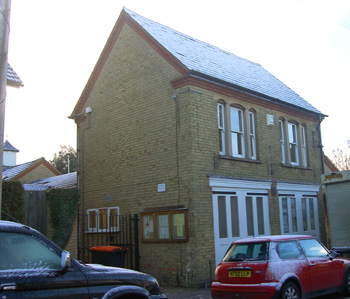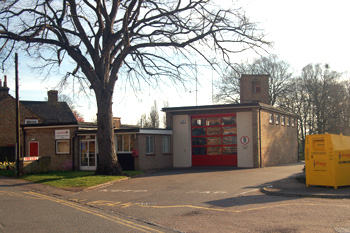Sandy Fire Station

The former Fire Station December 2010
It is presumed that Sandy had a fire engine from about the beginning of the 19th century. Engines in those days were usually in the care of the churchwardens and are thus mentioned in their accounts. Sadly the earliest churchwardens' accounts for Sandy do not begin until 1848 (though those for the hamlet of Girtford begin in 1804). Early engines were either horse drawn or hand pushed carts on which such things as buckets and hooks for pulling down burning thatch were festooned. There were also manual pumps with lengths of hose attached which could draw water from a river, lake or other nearby body of water or, of course, from water mains when they were introduced.
By 1864 the gas inspectors for Sandy were maintaining the fire engine, the firemen all being local men who were volunteers. The gas inspectors' minutes [LS329] for 1st February that year resolving: "we do … give instructions to the assistant overseer to keep the key of the Engine house and make the same known to the Parishioners at large". A resolution of 7th March read: "a board to be painted and put on the Engine house notifying that the key of the same is kept at Mr. Gregory's". The engine was to be taken out "from time to time for the purpose of seeing that it is in working order". By 2nd May it was obviously not in working order as five shillings had to be spent to make it so. More repairs (4/6) followed in June, a harness maker repairing the pipes and buckets.
The Bedfordshire Mercury of 4th May 1863 reports a significant fire, attended by the brigade: "FIRE BY A SPARK FROM A RAILWAY ENGINE. - A serious fire occurred at the Warren Farm, the property of Arthur Peel, Esq., and in the occupation of Mr. Robertson, on Monday morning last between nine and ten o'clock. The fire was caused by a spark thrown from an engine on the Bedford and Cambridge Railway. The Sandy, Potton and Biggleswade engines were quickly on the spot, but nearly the entire newly-erected farm buildings were destroyed and a large quantity of potatoes, and some farm implements and machinery. The damage is estimated at £800. Fortunately the house was saved, for at the time there were fifteen of the family at home".
A note in the minutes [LS329] of 5th September 1864 refers to this fire, stating that the North Western Railway Company were to be asked to compensate the men who attended the fire as a steam engine had been the cause of it. The note states that sixty three men had turned out and: "it was the general opinion, that, had our engine not been there the house and furniture must have fallen prey to the devouring element".
In 1865 two people were appointed "inspectors and sole controllers of the engine at all times without a salary". Another inspector was appointed under these two who would receive £5 per annum to clean and manage the engine.
In 1882 a new fire station was built at 10 Cambridge Road. The fire brigade remained a body manned by volunteers. The Rating and Valuation Act 1925 specified that every building and piece of land in the country was to be assessed to determine its rateable value. The valuer visiting the fire station [DV1/C147/30] noted it comprised a brick and slate engine house measuring 20 feet by 21 feet 6 inches with a parish room measuring 17 feet by 16 and a landing measuring 4 feet 6 inches by 7 feet 6 inches feet above. A yard and a small shed lay outside.
In 1938 all county, borough, rural and urban district councils were constituted as fire authorities by the Fire Brigades Act. Authorities, in the case of Sandy this would have been Sandy Urban District Council, were required to provide “the services for their borough or district of such a fire brigade and of such fire engines, appliances and equipment as may be necessary to meet efficiently all normal requirements”. In 1941 all fire brigades in the country were combined under the auspices of the National Fire Brigade to allow better co-operation in attending large bombing incidents. The Fire Services Act 1947 transferred local brigades to county councils or county boroughs, Sandy’s station and brigade thus became part of Bedfordshire Fire Brigade, now [2011] Bedfordshire and Luton Fire and Rescue Service.
![Opening of Ivel Road Fire Station in 1954 [FSD/PH9/1]](/CommunityHistories/Sandy/SandyImages/Opening of Ivel Road Fire Station in 1954 [FSD-PH9.jpg)
Opening of Ivel Road Fire Station in 1954 [FSD/PH9/1]
The current [2011] fire station in Ivel Road was opened on 24th July 1954 by Alan Lennox-Boyd. He was M. P. for Mid Bedfordshire from 1931 until 1960 when he was raised to the peerage as 1st Viscount Boyd of Merton. At the time of the opening of Sandy Fire Station he was Minister of Transport and Civil Aviation. The old station in Cambridge Road was purchased by Sandy Urban District Council, which used the building for storage. A history of the building produced by T. N. Stewart in 1999 [TCSandy35/4] states that the first floor of the premises was used by a firm of accountants and that for ten years from 1967 the ground floor was occupied as a surgery. It was in the year after the surgery vacated, 1978, that the property became the headquarters of Sandy Parish, now Town, Council which it remains at the time of writing. A plaque outside the building states that it was restored in 1999.
Until 1940 directories for the county were published every few years. Names of the captains of the Sandy Fire Brigade can be traced by using these and are as follows:
- 1877: Edwin Tomlin;
- 1885: Joseph Davison;
- 1890: John Spring;
- 1894 and 1898: Lot Hendry;
- 1903: James Henry Mead;
- 1906 and 1910: John William McDonald;
- 1914, 1920 and 1924: Fred Fennemore.
Sadly, after 1924 the directories only give the address of the fire station without giving the name of the captain.
 Sandy Fire Station in Ivel Road April 2010
Sandy Fire Station in Ivel Road April 2010